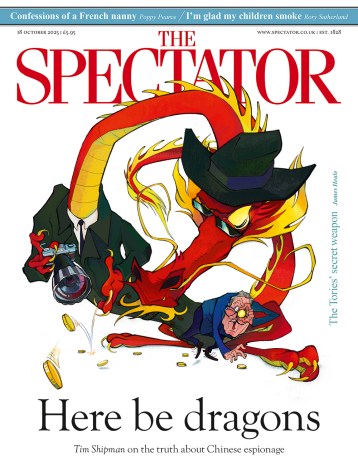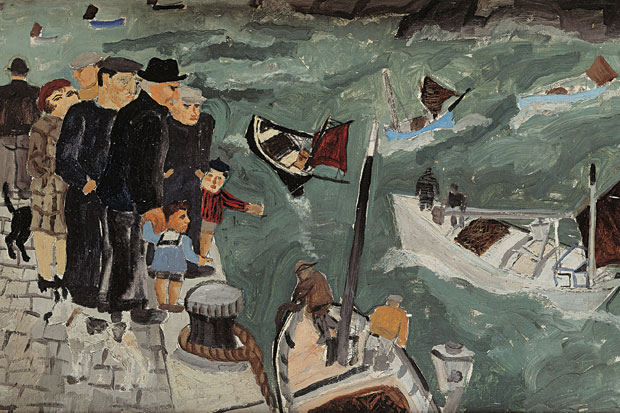This exhibition examines a loosely knit community of artists and their interaction over a decade at the beginning of the last century. It is centred around the marriage of Ben and Winifred Nicholson (which began to split up in 1931), involves their crucial joint-friendship with Christopher Wood and a fruitful exhibiting relationship with William Staite Murray, topped off by the all-pervading influence of a true original, Alfred Wallis, Cornish fisherman, marine-stores dealer and compulsive painter. The intellectual and artistic meeting of these individuals was a formative impulse in the development of Modernism in England; and it could be said — with some justification — that they brought out the best in each other. Certainly the exhibition has been selected and arranged to do just that.
What’s so clever about the hanging is the way even the visitor with some previous knowledge of these artists is provoked into thinking, ‘Well, who’s this by?’ Except for Wallis, whose naturally primitive approach is difficult to confuse, the closeness of the other three painters at this point in their careers means that you not only need to study each picture intently before looking at its label, but that when you do, you are still likely to be surprised by the identity of the artist. Clear-cut divisions are further blurred by all three painting the same or similar subjects. For instance, the show begins with two versions of Tippacott in Devon: a blue and green watercolour by Winifred on the left and a pencil drawing by Ben on the right. Aside from the difference in colour, the most noticeable thing is the similarity of direct structural approach.
The next group features a couple of flower paintings by Winifred (one of her specialities), flanking ‘Cortivallo, Lugano’ by Ben, a marvel of landscape minimalism and clarity. Here you can see his distinctive combination of oil and pencil, in which the pencil is not just under-drawing to be covered up by paint, but an expressive part of the final mark-making of the image. (Later Winifred can be observed borrowing this technique, though she tended to structure her work through colour rather than line.) On the opposite wall is Ben’s ‘1924 (first abstract painting, Chelsea)’, looking a little like a Matissean collage of cut and torn paper. To the left, by way of contrast, hangs a boldly abstracted hot landscape by Winifred, ‘Castagnola (Red Earth)’, and to the left of that is Ben’s cool/warm seascape of Dymchurch, in Kent, painted while staying with Paul Nash. Unlike Nash, who painted the sea wall and promenade, Ben looked straight out to sea and tipped up the shore and water like a table-top to run flatly up his canvas.
There are so many good paintings already on view that it’s almost possible to overlook the remarkable pots by William Staite Murray, yet the first cabinet has three beauties in it, particularly the stoneware bowl ‘Blossom’ and the vase ‘Roundabout’, with its merry-go-round horses. Herbert Read always said that you should judge the art of a country by its pottery, to gauge ‘the fineness of its sensibility’. William Staite Murray (1881–1962) saw himself not as a potter, but as an artist who made pots. For him, pottery existed somewhere between sculpture and painting, partaking of both and capable of contributing to their development. Murray first exhibited his work with Wood and the Nicholsons in 1927, and their shared aims made the future juxtaposition of their art a logical eventuality. The conversation between the paintings and pots in this show is a subtle and lively one, by no means limited to the obvious relationship between the painters’ still-life subjects and the actual grouping of pots in adjoining cabinets. (Note the two lovely still-lifes of jars, mugs and goblets by Ben hanging nearby.) These artists all adhered to the same aesthetic.
Murray, one of the first Buddhists in England, paid particular attention to the spiritual component of his work. As the potter and writer Julian Stair observes in the catalogue: ‘Art was not perceivable by the rational mind alone, and Murray used terms such as “feeling judgment” and “form attunement” to describe the spiritual nature of the creative process and its concordant “sense of ultimate reality”.’ His oriental-feeling ‘Cadence’ and ‘Vortex’, both exceptional pieces, made me think of Mary Potter, whose paintings would also not look out of place here. In the Nicholson and Wood paintings, the spiritual element can best be seen in the rolling Cumberland landscape, here focused and distilled in a memorable trio: Ben’s ‘Cumberland Farm’, and two other versions of the same subject, Northrigg Hill, by Winifred and Wood.
This is a great group — one of the finest of the show, including as it does one of Winifred’s most direct landscapes. Wood owned the Ben painting, with its scraped-down sky and sumptuous passages of duck-egg blue against ochre and umber. Opposite there’s a corner of high-powered still-life (note the use of pink), moving round to another poignant Winifred landscape, ‘Summer’, and very different versions of Pill Creek in Cornwall by Ben and Wood, with a fine Wallis riding with them. Another series of Cumberland landscapes, all featuring animals as emblematic as chalk figures cut into the hillsides, show how the Nicholsons responded to each other’s work and to their talented friend Christopher Wood, but also how they differed in approach. And so the show goes on, with inspiring clusters and revealing juxtapositions — such as putting Ben’s ‘Cornish Port’ next to Wallis’s ‘Four Luggers and a Lighthouse’.
The exhibition is accompanied by a well-illustrated and informative book/catalogue (£19.50 in paperback from Philip Wilson Publishers), but however good, the publication is no substitute for seeing the show. Much of the exhibition’s meaning is only delivered through the intelligent juxtaposition of paintings, drawings and pots: you have to experience their dispositions to obtain the full value of this excellent selection. The work has been expertly hung and installed at Kettle’s Yard and the gallery space is deeply sympathetic to it. I wonder what it will look like at Dulwich Picture Gallery when the exhibition transfers there next month. (It will be on display in London from 4 June until 21 September.) I would recommend a visit to Cambridge simply because the light and atmosphere of Kettle’s Yard suit the work so well. But whether you see it there or in London, do not fall into the trap of thinking that this is just a round-up of the usual suspects. The careful selection of specific works and their potent apposition teaches us a great deal about a group of artists we may have thought reassuringly familiar.






Comments